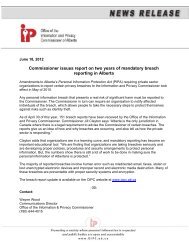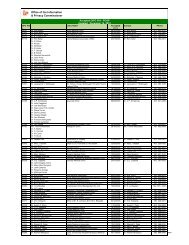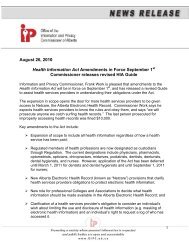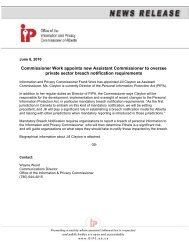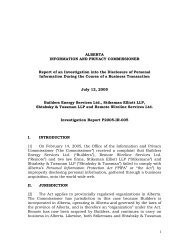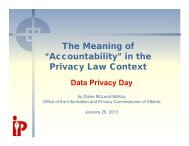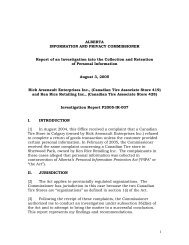cloud computing for small- and medium-sized enterprises
cloud computing for small- and medium-sized enterprises
cloud computing for small- and medium-sized enterprises
Create successful ePaper yourself
Turn your PDF publications into a flip-book with our unique Google optimized e-Paper software.
CLOUD COMPUTING FOR SMALL- AND MEDIUM-SIZED<br />
ENTERPRISES:<br />
Privacy Responsibilities <strong>and</strong> Considerations<br />
Cloud <strong>computing</strong> is the delivery of <strong>computing</strong> services over the Internet, <strong>and</strong> it offers many<br />
potential benefits to <strong>small</strong> <strong>and</strong> <strong>medium</strong>-<strong>sized</strong> <strong>enterprises</strong> (SMEs). For example, implementing<br />
in<strong>for</strong>mation technology solutions <strong>and</strong> plat<strong>for</strong>ms can be complex <strong>and</strong> costly <strong>for</strong> SMEs. Cloud<br />
<strong>computing</strong> can often help ease this burden by enabling SMEs to access services that they might<br />
not have the money or resources to implement or support on their own. Many organizations may<br />
employ <strong>cloud</strong> <strong>computing</strong> solutions as part of their overall business strategy, allowing them to<br />
focus on their core business.<br />
Organizations may turn to <strong>cloud</strong> <strong>computing</strong> services <strong>for</strong> data processing, storage <strong>and</strong> backup, to<br />
facilitate productivity, <strong>for</strong> accounting services, <strong>for</strong> communications, or <strong>for</strong> customer service <strong>and</strong><br />
support. There are privacy implications, however, if personal in<strong>for</strong>mation is being h<strong>and</strong>led by a<br />
<strong>cloud</strong> provider.<br />
The Office of the Privacy Commissioner of Canada (OPC) has developed an Introduction to Cloud<br />
Computing, which provides general in<strong>for</strong>mation on <strong>cloud</strong> <strong>computing</strong> <strong>and</strong> the privacy challenges it<br />
presents, <strong>and</strong> includes answers to a number of frequently asked questions.<br />
This guidance document, prepared jointly by the OPC <strong>and</strong> the Offices of the In<strong>for</strong>mation <strong>and</strong><br />
Privacy Commissioner of Alberta <strong>and</strong> British Columbia is specifically intended to help SMEs<br />
underst<strong>and</strong> what their privacy responsibilities are <strong>and</strong> to offer some suggestions to address<br />
privacy considerations in the <strong>cloud</strong>. This document should be read in conjunction with the<br />
Introduction to Cloud Computing document.<br />
Other related resources are referenced at the end of this document.<br />
Are you already in the <strong>cloud</strong>?<br />
As a first step, SMEs should examine their organization to determine if any of their business<br />
activities already involve outsourcing personal in<strong>for</strong>mation to a <strong>cloud</strong> <strong>computing</strong> service.<br />
Frequently, organizations find that employees have already moved personal in<strong>for</strong>mation to a<br />
<strong>cloud</strong> service without IT staff or management being aware. For example:<br />
<br />
<br />
<br />
Do employees use a <strong>cloud</strong>-based e-mail service <strong>for</strong> business correspondence?<br />
Do employees use an online service to collaborate on documents containing personal<br />
customer in<strong>for</strong>mation?<br />
Can client databases be accessed online from any location?<br />
1
Consider the risks & benefits of moving to the Cloud.<br />
Cloud <strong>computing</strong> is a type of outsourcing. While <strong>cloud</strong> <strong>computing</strong> may provide efficiencies, as<br />
noted above, there are potential risks related to the use of a <strong>cloud</strong> service provider. If an<br />
organization chooses to outsource personal data <strong>for</strong> processing or other services to a <strong>cloud</strong><br />
service provider, it remains accountable <strong>for</strong> protecting its customers’ personal in<strong>for</strong>mation <strong>and</strong> it<br />
must be transparent about its in<strong>for</strong>mation management <strong>and</strong> privacy practices.<br />
Organizations must ensure they fully underst<strong>and</strong> their obligations under Canada’s private sector<br />
privacy legislation, including those under certain provincial privacy legislation 1 , <strong>and</strong> they need to<br />
carefully assess the risks against the benefits. Organizations considering a <strong>cloud</strong> <strong>computing</strong><br />
service should carefully consider what in<strong>for</strong>mation will be stored in the <strong>cloud</strong> <strong>and</strong> why.<br />
Organizations must consider the sensitivity of the personal in<strong>for</strong>mation <strong>and</strong> carefully assess all<br />
the risks <strong>and</strong> implications involved in outsourcing personal data to the <strong>cloud</strong>. This assessment<br />
should also take into account whether the <strong>cloud</strong> is a public <strong>cloud</strong>, community <strong>cloud</strong>, private <strong>cloud</strong><br />
or hybrid <strong>cloud</strong>, as defined in the OPC’s Introduction to Cloud Computing.<br />
The sensitivity of the in<strong>for</strong>mation, the type of <strong>cloud</strong>, <strong>and</strong> the contractual arrangements should all<br />
play a key role in an organization’s decision to move, or not to move, personal in<strong>for</strong>mation to the<br />
<strong>cloud</strong>. It may be beneficial to consult a professional <strong>for</strong> assistance in assessing the risks of using<br />
a <strong>cloud</strong> service provider.<br />
Take accountability into account. What does the contract say?<br />
Under Canada’s private sector privacy legislation, an organization that collects personal<br />
in<strong>for</strong>mation from an individual is accountable <strong>for</strong> the personal in<strong>for</strong>mation even when it is<br />
outsourced <strong>for</strong> processing to third-party providers. What this means is that all businesses in<br />
Canada, regardless of their size, are ultimately accountable <strong>for</strong> the personal in<strong>for</strong>mation they<br />
collect, use <strong>and</strong> disclose even if they outsource personal in<strong>for</strong>mation to a service provider that<br />
operates in the <strong>cloud</strong>.<br />
Organizations sometimes find that <strong>cloud</strong> providers present “take it or leave it” contracts. In other<br />
words, the provider sets the parameters of the relationship, <strong>and</strong> the contracting organization is<br />
required to go along with it in order to use the service. This tends to be the case with free online<br />
services offered by <strong>cloud</strong> providers. The concern is that the terms of service that govern the<br />
relationship with the <strong>cloud</strong> service provider sometimes allow <strong>for</strong> more liberal usage of personal<br />
in<strong>for</strong>mation <strong>and</strong> retention practices, <strong>and</strong> these st<strong>and</strong>ard contract clauses may not be sufficient to<br />
allow SMEs to meet their privacy obligations. Moreover, it may be problematic if the <strong>cloud</strong><br />
provider is able to unilaterally change the agreement, limit its liability <strong>for</strong> the in<strong>for</strong>mation, <strong>and</strong>/or<br />
subcontract to various other providers.<br />
1 The Personal In<strong>for</strong>mation Protection <strong>and</strong> Electronic Documents Act (PIPEDA) <strong>and</strong> substantially similar provincial<br />
laws, including, Alberta’s Personal In<strong>for</strong>mation Protection Act (PIPA); <strong>and</strong> British Columbia’s Personal In<strong>for</strong>mation<br />
Protection Act (PIPA). Although the specifics of all three pieces of legislation may differ, they are all deemed to be<br />
substantially similar in content <strong>and</strong> contain the same fundamental principles. In some provinces, an organization<br />
may be subject to specific notification requirements in accordance with provincial privacy legislation. In Alberta <strong>for</strong><br />
example, there are specific breach notification requirements <strong>and</strong> requirements to notify individuals when personal<br />
in<strong>for</strong>mation is transferred to a service provider located outside of Canada.<br />
2
SMEs in particular might be more likely to encounter a ‘take it or leave it’ situation than larger<br />
organizations that have more resources to push back on such contracts, or set up a private<br />
<strong>cloud</strong>. Still, the accountability remains with the outsourcing organization even if the service is<br />
free, or if the <strong>cloud</strong> provider sets a “take it or leave it” contract. As noted in the Introduction to<br />
Cloud Computing – FAQs, any organization using a <strong>cloud</strong> service must carefully review the <strong>cloud</strong><br />
provider’s terms of service <strong>and</strong> ensure that the personal in<strong>for</strong>mation it entrusts to the provider<br />
will be treated in a manner consistent with its privacy obligations under relevant privacy<br />
legislation. In short, SMEs must use contractual or other means to ensure that personal<br />
in<strong>for</strong>mation is appropriately h<strong>and</strong>led <strong>and</strong> protected by the <strong>cloud</strong> provider. The bottom line? If you<br />
are not com<strong>for</strong>table with what a particular <strong>cloud</strong> provider is proposing, you should not transfer<br />
personal in<strong>for</strong>mation entrusted to you by your customers to that provider. You should push back,<br />
or take the time to shop around <strong>for</strong> a better solution. Check out other providers <strong>and</strong> confer with<br />
other similar businesses or your industry association to see what options may be available.<br />
For additional guidance on accountability, consult Getting Accountability Right with a Privacy<br />
Management Program, which was prepared jointly by the Offices of the In<strong>for</strong>mation <strong>and</strong> Privacy<br />
Commissioners of British Columbia <strong>and</strong> Alberta, <strong>and</strong> the Office of the Privacy Commissioner of<br />
Canada.<br />
Is the <strong>cloud</strong> secure?<br />
Security in the <strong>cloud</strong> is of paramount importance. Massive online databases are attractive to<br />
cybercriminals, <strong>and</strong> Internet services have proven to be difficult to protect. Organizations must<br />
protect personal in<strong>for</strong>mation with safeguards appropriate to the sensitivity of the in<strong>for</strong>mation<br />
they h<strong>and</strong>le. Tools such as Privacy Impact Assessments (PIA) or Threat Risk Assessments (TRA)<br />
could be valuable to help make assessments of safeguards. In order to ensure that personal<br />
in<strong>for</strong>mation is protected, organizations using <strong>cloud</strong> <strong>computing</strong> services should:<br />
<br />
<br />
<br />
Limit access to the in<strong>for</strong>mation <strong>and</strong> restrict further uses by the provider. Set<br />
parameters <strong>for</strong> restricted access <strong>and</strong> use of personal in<strong>for</strong>mation that is appropriate <strong>for</strong><br />
the context <strong>and</strong> sensitivity of the in<strong>for</strong>mation. Find out if personal in<strong>for</strong>mation will be<br />
segregated or stored in the same database as in<strong>for</strong>mation from the <strong>cloud</strong> provider’s other<br />
clients. Ensure access to personal in<strong>for</strong>mation is only granted to those who need it to do<br />
their job. Ensure that access to personal in<strong>for</strong>mation is logged in protected audit trails.<br />
Do not assume that the provider’s general terms of service or policies will be adequate to<br />
establish such restrictions, review them carefully.<br />
Ensure that the provider has in place appropriate authentication/access<br />
controls. Stronger methods of authentication are recommended, such as multi-factor<br />
authentication 2 . The level of authentication should be commensurate with the risk to the<br />
personal in<strong>for</strong>mation being protected. Ensure there are procedures <strong>and</strong> technical controls<br />
to manage who has access rights to the personal in<strong>for</strong>mation.<br />
Manage encryption. Underst<strong>and</strong> what type of encryption method is being used <strong>and</strong><br />
identify where data is encrypted or unencrypted at each stage (e.g., data in transit, data<br />
at rest). Conduct an assessment of the risks associated with any lack of encryption.<br />
2 Refer to our Guidance on Identification <strong>and</strong> Authentication <strong>for</strong> an explanation of multi-factor authentication.<br />
3
Determine if the encryption method is adequate <strong>and</strong> the access to encryption keys is<br />
properly managed. Risks may be reduced if organizations encrypt personal in<strong>for</strong>mation<br />
be<strong>for</strong>e it is sent to the <strong>cloud</strong> provider.<br />
<br />
<br />
<br />
<br />
Ensure that there are procedures in place in the event of a personal in<strong>for</strong>mation<br />
breach or security incident. These should include technical <strong>and</strong> organizational<br />
measures that will be implemented in the event of accidental or deliberate loss, or<br />
unauthorized access or disclosure of personal in<strong>for</strong>mation. Ensure there are provisions in<br />
the agreement with the <strong>cloud</strong> provider that specify when it will provide notification to the<br />
organization in the event of a security breach. Organizations subject to breach<br />
notification requirements will want to ensure the contract is clear about when the <strong>cloud</strong><br />
provider is to provide reports on breaches in order <strong>for</strong> it to meet its legal obligation 3 .<br />
Ensure that there are procedures in place in the event of an outage to ensure<br />
business continuity <strong>and</strong> prevent data loss. Business continuity plans should be<br />
clearly documented in the contract.<br />
Ensure periodic audits are per<strong>for</strong>med. It is important <strong>for</strong> an organization to have<br />
some measure of oversight over a <strong>cloud</strong> provider’s policies <strong>and</strong> practices. Ensure the<br />
<strong>cloud</strong> provider logs all accesses <strong>and</strong> uses of personal in<strong>for</strong>mation. Audits should be<br />
conducted periodically to inspect access logs <strong>and</strong> confirm that physical locations where<br />
personal in<strong>for</strong>mation is processed <strong>and</strong> stored are inspected. Organizations should verify<br />
practices <strong>and</strong> procedures to ensure the provider is h<strong>and</strong>ling personal in<strong>for</strong>mation in<br />
accordance with the agreements in place <strong>and</strong> request evidence of effective auditing <strong>and</strong><br />
timely response to security incidents.<br />
Have an exit strategy. Ensure the termination procedures permit the transfer of<br />
personal in<strong>for</strong>mation back to the organization <strong>and</strong> require that the <strong>cloud</strong> provider<br />
securely delete all personal in<strong>for</strong>mation within reasonable <strong>and</strong> specified timeframes.<br />
If your organization needs help evaluating its personal in<strong>for</strong>mation protection readiness, you can<br />
consult the Securing Personal In<strong>for</strong>mation: A Self-Assessment Tool <strong>for</strong> Organizations, which was<br />
prepared jointly by the Offices of the In<strong>for</strong>mation <strong>and</strong> Privacy Commissioners of British Columbia<br />
<strong>and</strong> Alberta, <strong>and</strong> the Office of the Privacy Commissioner of Canada.<br />
State your purpose. Do you have your customer’s consent?<br />
An organization needs to ensure that appropriate consents have been obtained if it plans to<br />
outsource personal in<strong>for</strong>mation to a third-party <strong>cloud</strong> provider. If an organization has obtained<br />
an individual’s consent to collect <strong>and</strong> use personal in<strong>for</strong>mation <strong>for</strong> a specific purpose, it does not<br />
need separate consent when outsourcing to a <strong>cloud</strong> provider to process the in<strong>for</strong>mation <strong>for</strong> the<br />
same purpose outlined at the time of collection. Ideally, at the time of collection, organizations<br />
should in<strong>for</strong>m customers in clear <strong>and</strong> underst<strong>and</strong>able language that their in<strong>for</strong>mation may be<br />
processed by a third-party service provider.<br />
3 In some provinces, an organization may be subject to specific breach notification requirements<br />
4
Establish limits. Have you specified what the <strong>cloud</strong> provider can do with<br />
the data?<br />
Organizations need to be cautious about “function-creep”, where a <strong>cloud</strong> provider may use the<br />
in<strong>for</strong>mation <strong>for</strong> purposes other than those <strong>for</strong> which it was collected. Organizations need to<br />
maintain control over personal in<strong>for</strong>mation that is sent to a <strong>cloud</strong> provider, <strong>and</strong> take steps to<br />
prevent <strong>and</strong> limit secondary uses of personal in<strong>for</strong>mation. However, if there is concern that the<br />
contractual arrangement would permit the <strong>cloud</strong> provider to use the in<strong>for</strong>mation <strong>for</strong> other<br />
reasons (such as targeted advertising) separate consent would be required from customers <strong>for</strong><br />
any secondary or new uses of their personal in<strong>for</strong>mation. 4<br />
Be<strong>for</strong>e moving personal in<strong>for</strong>mation to the <strong>cloud</strong>, organizations need to:<br />
<br />
<br />
<br />
Clarify what, if anything, the prospective <strong>cloud</strong> provider will do with the<br />
in<strong>for</strong>mation. Will it analyze the data <strong>for</strong> its own purposes? Will it sell it? Will it subcontract<br />
certain activities related to the <strong>cloud</strong> service? Will the data be segregated or<br />
stored with data from the provider’s other clients? Ensure that these activities will not<br />
result in a violation of privacy obligations <strong>and</strong> raise any concerns you have directly with<br />
the <strong>cloud</strong> service provider.<br />
Seek customers’ consent <strong>for</strong> new uses of their personal in<strong>for</strong>mation. If the <strong>cloud</strong><br />
provider purports to use the personal in<strong>for</strong>mation <strong>for</strong> purposes other than the specific<br />
purposes <strong>for</strong> which the personal in<strong>for</strong>mation was initially collected, then separate consent<br />
<strong>for</strong> that new use is required. If customers do not consent, or revoke consent, you need to<br />
ensure that you can comply with their requests.<br />
Always keep in mind the reasonable expectations of the individual. What would<br />
your customers think of the proposed uses? You need to maintain the trust of your<br />
customers, while providing them with the best possible service <strong>and</strong> protection.<br />
Transparency is key. What will your customers expect?<br />
Individuals will expect that their personal in<strong>for</strong>mation is protected, regardless of where it's<br />
processed or stored, <strong>and</strong> will also expect an organization to be transparent when personal<br />
in<strong>for</strong>mation is outsourced to a <strong>cloud</strong> provider. Organizations should use clear <strong>and</strong> underst<strong>and</strong>able<br />
language to in<strong>for</strong>m individuals that their personal in<strong>for</strong>mation will be transferred to a <strong>cloud</strong><br />
provider, that their personal in<strong>for</strong>mation may be stored or processed in a <strong>for</strong>eign country <strong>and</strong><br />
that it may be accessible to law en<strong>for</strong>cement <strong>and</strong> national security authorities of that jurisdiction.<br />
4 However, there are limited exceptions that may apply in certain circumstances, <strong>for</strong> example, when new uses or<br />
disclosures are authorized by law.<br />
5
The <strong>cloud</strong> crosses borders. Do you underst<strong>and</strong> how the law will apply?<br />
Canada’s private sector privacy legislation does not prohibit organizations in Canada from<br />
transferring personal in<strong>for</strong>mation to an organization in another jurisdiction <strong>for</strong> processing. 5<br />
However, organizations should consider the sensitivity of the personal in<strong>for</strong>mation they plan to<br />
outsource <strong>and</strong> evaluate the potential risks that may occur when moving personal in<strong>for</strong>mation<br />
outside the country. Organizations need to recognize that personal in<strong>for</strong>mation that is<br />
transferred to another country is subject to the laws of that jurisdiction. In the case of <strong>cloud</strong><br />
<strong>computing</strong>, data that is outsourced may be physically located in several jurisdictions. Moreover,<br />
the <strong>cloud</strong> provider’s backup servers could be in a different physical location than the primary<br />
servers. It is important to underst<strong>and</strong> where the data will reside to fully comprehend the legal<br />
regimes <strong>for</strong> protecting personal in<strong>for</strong>mation, <strong>and</strong> the circumstances under which data may be<br />
accessed by <strong>for</strong>eign courts, government agencies, <strong>and</strong> law en<strong>for</strong>cement.<br />
It is also important to be aware of the limitations <strong>for</strong> obtaining judgements <strong>and</strong> en<strong>for</strong>cing<br />
contracts. No contract, no matter how well crafted, can override the laws of the <strong>for</strong>eign<br />
jurisdiction. Moreover, generally an organization can only en<strong>for</strong>ce the provisions of a contract<br />
against the other party to the contract, <strong>and</strong> not third-parties. In a <strong>for</strong>eign jurisdiction, obtaining<br />
judgements to en<strong>for</strong>ce contracts may be difficult <strong>and</strong> costly <strong>for</strong> the outsourcing organization. It<br />
may prove to be equally difficult to en<strong>for</strong>ce a judgement in a <strong>for</strong>eign jurisdiction.<br />
For additional guidance on transborder data flows, see the OPC’s Guidelines <strong>for</strong> Processing<br />
Personal Data Across Borders. These considerations apply whether an organization is moving<br />
data into the <strong>cloud</strong>, or otherwise transferring personal in<strong>for</strong>mation across borders.<br />
It’s important to maintain control. Are you in the driver’s seat?<br />
Organizations have obligations under privacy laws that include enabling customers to access<br />
their personal in<strong>for</strong>mation, request corrections, <strong>and</strong> resolve issues <strong>and</strong> complaints. Accordingly,<br />
an organization must ensure that its relationship with the <strong>cloud</strong> provider allows it to meet these<br />
obligations under privacy law. For example, the organization must have the ability to access data<br />
at any time (including backups <strong>and</strong> archives), make corrections, <strong>and</strong> investigate any allegations<br />
of non-compliance with privacy obligations. In the event of a breach, organizations will also want<br />
control over the procedures to notify affected individuals.<br />
Outsourcing the h<strong>and</strong>ling of personal in<strong>for</strong>mation to a <strong>cloud</strong> provider means that the <strong>cloud</strong><br />
provider will have custody of the personal in<strong>for</strong>mation. As such, an organization needs to be<br />
cautious that it does not lose control of the personal in<strong>for</strong>mation transferred to the <strong>cloud</strong><br />
provider. Maintaining control means that data ownership is clearly defined in the contract <strong>and</strong><br />
includes statements about what the provider can do with the personal in<strong>for</strong>mation <strong>and</strong> what will<br />
happen to the personal in<strong>for</strong>mation if the provider ceases to operate. Part of maintaining control<br />
also means that an organization has the ability to terminate the contract, retrieve the data from<br />
the <strong>cloud</strong> provider, <strong>and</strong> have the <strong>cloud</strong> provider attest that no personal in<strong>for</strong>mation is retained in<br />
its systems, or any of its subcontractor’s systems.<br />
5 However, it’s important to underst<strong>and</strong> specific legal obligations that exist under some provincial privacy laws. For<br />
example, Section 13.1 (2) of Alberta’s Personal In<strong>for</strong>mation Protection Act requires organizations to provide notice<br />
to individuals at or be<strong>for</strong>e the time of collection of their personal in<strong>for</strong>mation, if their personal in<strong>for</strong>mation will be<br />
transferred to a service provider located outside of Canada. The notice must be in a <strong>for</strong>m <strong>and</strong> contain the<br />
in<strong>for</strong>mation specified section 13.1 (3) of Alberta’s Personal In<strong>for</strong>mation Protection Act.<br />
6
Portability is a key component of control; portability refers to the ability to move data across<br />
different plat<strong>for</strong>ms with minimal integration issues. If the provider uses proprietary <strong>for</strong>mats it<br />
may be more difficult <strong>for</strong> an organization to move the data back in-house or to another provider.<br />
Organizations might also find it useful to use a <strong>cloud</strong> provider that has a person designated with<br />
responsibility <strong>for</strong> privacy. This person would ideally be identified in a contract <strong>and</strong> be accessible<br />
should the organization have any questions or concerns, or need to re-evaluate policies <strong>and</strong><br />
procedures.<br />
Make an in<strong>for</strong>med decision.<br />
Organizations must take care to fully assess the benefits, risks, <strong>and</strong> implications <strong>for</strong> privacy<br />
when considering a <strong>cloud</strong> <strong>computing</strong> solution. In a separate annex we have compiled a list of<br />
some* key questions that organizations should take into account when shopping <strong>for</strong> a <strong>cloud</strong><br />
<strong>computing</strong> solution.<br />
For more in<strong>for</strong>mation <strong>and</strong> guidance, please see:<br />
1) Fact Sheet: Introduction to Cloud Computing:<br />
http://www.priv.gc.ca/resource/fs-fi/02_05_d_51_cc_e.asp<br />
2) Reaching <strong>for</strong> the Cloud(s):<br />
http://www.priv.gc.ca/in<strong>for</strong>mation/pub/cc_201003_e.asp<br />
3) The Report on the 2010 Office of the Privacy Commissioner of Canada’s Consultations on Online<br />
Tracking, Profiling <strong>and</strong> Targeting, <strong>and</strong> Cloud Computing:<br />
http://www.priv.gc.ca/resource/consultations/report_201105_e.asp<br />
4) Guidelines <strong>for</strong> Processing Personal Data Across Borders:<br />
http://www.priv.gc.ca/in<strong>for</strong>mation/guide/2009/gl_dab_090127_e.asp<br />
5) Securing Personal In<strong>for</strong>mation: A Self-Assessment Tool <strong>for</strong> Organizations (prepared jointly by the<br />
Offices of the In<strong>for</strong>mation <strong>and</strong> Privacy Commissioners of British Columbia <strong>and</strong> Alberta, <strong>and</strong> the<br />
Office of the Privacy Commissioner of Canada):<br />
http://www.priv.gc.ca/resource/tool-outil/security-securite/english/AssessRisks.asp?x=1<br />
6) Guideline on Identification <strong>and</strong> Authentication:<br />
http://www.priv.gc.ca/in<strong>for</strong>mation/guide/auth_061013_e.asp<br />
7) Getting Accountability Right with a Privacy Management Program:<br />
http://www.priv.gc.ca/in<strong>for</strong>mation/guide/2012/gl_acc_201204_e.asp<br />
* This list is intended as a guide <strong>and</strong> is not an exhaustive risk analysis. It is an organization’s<br />
responsibility to fully assess the risks/benefits that are specific to its context, <strong>and</strong> in some cases,<br />
it may be beneficial to consult a professional.<br />
7
!<br />
Cloud Computing Key Questions<br />
Why the <strong>cloud</strong>?<br />
What in<strong>for</strong>mation do you plan to outsource <strong>and</strong> why?<br />
How sensitive is the personal in<strong>for</strong>mation?<br />
What are the benefits <strong>and</strong> what are the risks <strong>and</strong> privacy implications <strong>for</strong> your<br />
customers?<br />
What are the risks to your company?<br />
What are your privacy obligations under relevant privacy legislation?<br />
What are the implications <strong>for</strong> your customers if their data is compromised?<br />
Accountability – contract clauses<br />
Does the contract address all aspects of privacy compliance?<br />
Does your organization control the in<strong>for</strong>mation, including how it is used, how it<br />
is accessed, <strong>and</strong> how long it will be retained?<br />
Who has control of the personal in<strong>for</strong>mation if your organization, or the <strong>cloud</strong><br />
provider, ceases to operate?<br />
Will the <strong>cloud</strong> provider subcontract services, which may involve access by, or<br />
transfer of in<strong>for</strong>mation, to another provider?<br />
Will you be able to review the provider’s processes <strong>and</strong> procedures?<br />
Has the <strong>cloud</strong> provider claimed limited liability in the event of a breach?<br />
Are there termination procedures that will allow you to recover personal<br />
in<strong>for</strong>mation?<br />
Do the termination procedures require the <strong>cloud</strong> provider to securely delete<br />
personal in<strong>for</strong>mation within reasonable <strong>and</strong> specified timeframes?<br />
Security<br />
Will the data be segregated or stored with data from other organizations that<br />
use the same <strong>cloud</strong> provider?<br />
When <strong>and</strong> how is the in<strong>for</strong>mation encrypted? Is the method adequate?<br />
What are the risks at the points where in<strong>for</strong>mation is not encrypted?<br />
What are the procedures <strong>for</strong> authentication? Are they adequate relative to the<br />
sensitivity of the in<strong>for</strong>mation?<br />
Are there policies <strong>and</strong> procedures that restrict access to the data?<br />
What are the technical <strong>and</strong> organizational measures that will be implemented in<br />
the event of accidental or deliberate loss of data, or unauthorized access or<br />
disclosure?<br />
What are the notification procedures in the event of a security breach?<br />
Do you have the ability to obtain evidence of effective auditing?<br />
What is the disaster recovery plan?<br />
Have you outlined an exit strategy?<br />
8
Secondary uses<br />
What will the prospective <strong>cloud</strong> provider do with the in<strong>for</strong>mation?<br />
Will the provider analyze the data <strong>for</strong> its own purposes?<br />
Could the provider sell the in<strong>for</strong>mation?<br />
Will the provider use or allow access to the in<strong>for</strong>mation <strong>for</strong> targeted advertising?<br />
Will any of these secondary uses result in your organization’s non-compliance<br />
with applicable privacy laws?<br />
Knowledge, Consent <strong>and</strong> Transparency<br />
Are your customers aware that you will be sharing their in<strong>for</strong>mation with a third<br />
party? Where applicable, have you met your notice requirements?<br />
Will the <strong>cloud</strong> provider process the in<strong>for</strong>mation <strong>for</strong> the same purpose <strong>for</strong> which<br />
you collected it? Do you have your customers’ consent?<br />
Would your customers reasonably expect their in<strong>for</strong>mation to be used <strong>for</strong> that<br />
purpose?<br />
If this is a new purpose, what is your plan to advise your customers <strong>and</strong> obtain<br />
additional consent?<br />
Do you have a plan to respond to cases where customers do not consent or<br />
withdraw consent to a new use?<br />
Control, Accessibility <strong>and</strong> Portability<br />
Is there a risk that the <strong>cloud</strong> provider could refuse to give your data back to<br />
you?<br />
Does your relationship with the <strong>cloud</strong> provider allow you meet obligations <strong>for</strong><br />
allowing individuals access to their personal in<strong>for</strong>mation?<br />
Do you control the notification procedures in the event of a breach?<br />
Will the data stored by the <strong>cloud</strong> provider be portable? Will you be able to<br />
transfer the personal in<strong>for</strong>mation back in-house or to another provider?<br />
Does the <strong>cloud</strong> provider have a designated privacy person that is accessible?<br />
Do you have the ability to access data at any time, make corrections, <strong>and</strong><br />
investigate any allegations of non-compliance with privacy obligations?<br />
Will you lose control of personal in<strong>for</strong>mation to your provider’s subcontracted<br />
providers?<br />
Jurisdiction <strong>and</strong> access<br />
Where will the data be stored?<br />
What are the risks in outsourcing to that jurisdiction?<br />
What <strong>for</strong>eign entities could potentially have access to the in<strong>for</strong>mation?<br />
What are the <strong>cloud</strong> provider’s policies with respect to access to in<strong>for</strong>mation<br />
requests?<br />
Will a warrant or subpoena be required prior to granting access to <strong>for</strong>eign<br />
courts, government agencies, <strong>and</strong> law en<strong>for</strong>cement?<br />
Will the <strong>cloud</strong> provider in<strong>for</strong>m your organization if data is requested or disclosed<br />
pursuant to a legal requirement?<br />
Will the <strong>cloud</strong> provider seek direction from your organization prior to sharing !<br />
in<strong>for</strong>mation with others, including law en<strong>for</strong>cement?<br />
!<br />
9



